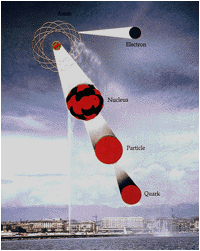The theories and discoveries of thousands of physicists over the past century have created a remarkable—and remarkably accurate —picture of the fundamental structure of matter, the Standard Model of Particles and Forces.
 The Standard Model describes four forces, transmitted by elementary particles: the photon transmits the electromagnetic force; the gluon carries the strong nuclear force that holds the atom's nucleus together, and the W and Z bosons transmit the weak force that acts
in radioactive decay.
The Standard Model describes four forces, transmitted by elementary particles: the photon transmits the electromagnetic force; the gluon carries the strong nuclear force that holds the atom's nucleus together, and the W and Z bosons transmit the weak force that acts
in radioactive decay.
The fundamental particles of matter are leptons, such as the familiar electron, and quarks, like those found inside the proton and neutron. Each elementary particle of matter also has an antimatter partner. For example, the positron is the antimatter counterpart of the electron, and every quark has an antiquark.
Every phenomenon observed in nature can be understood as the interplay of the fundamental forces and particles of the Standard Model.
But physicists know that the Standard Model is not the end of the story. It does not account for gravity. And it raises almost as many questions as it answers. Today physicists are searching for physics beyond the Standard Model that will lead them to a larger, more elegant theory—a "theory of everything."